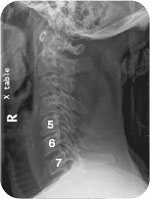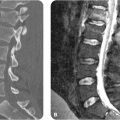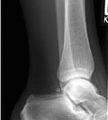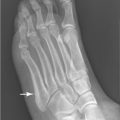George M. Bridgeforth and Mark Nolden
A 53-year-old restrained male driver is involved in a motor vehicle collision. he presents with posterior neck pain.

CLINICAL POINTS
- Wedge compression fractures are caused by spinal flexion.
- Neurological signs of spinal shock (numbness, weakness, absent reflexes, loss of bowel tone) may occur.
Clinical Presentation
Patients with clinically significant spinal cord injuries may present acutely without or without discernable neurological impairment. They may have low blood pressure associated with acute tetraplegia (quadriplegia) as well as loss of reflexes and bowel tone, which are classic indicators of spinal shock. Spinal shock is usually seen with severe spinal cord injuries above the midthoracic area.
The neurological examination is based on the last intact neurological level, and a functional classification is determined on the basis of the Frankel classification (see Chapter 3) and the American Spinal Injury Association (ASIA) classification. The ASIA classification system includes five levels (Box 4.1).
Wedge fractures are usually stable injuries caused by excessive flexion. They occur more commonly in the cervical region. The most common levels or cervical spinal cord injury are C5 and C6. If a tetraplegic patient exhibits loss of motor function with intact sensation extending to the S4–S5 region (i.e., the perianal region), he or she is a class B tetraplegic. If the patient has accompanying nonfunctional motor weakness (less than grade 3) below the level of the spinal cord injury, he or she is a class C tetraplegic. If the patient has at least half of the muscles with functional movement (grade 3 or greater) below the level of the spinal cord injury, he or she is a C5 class D tetraplegic. A C5 class A tetraplegic has intact biceps function (C5 muscle) but motor and sensory impairment below that level. A C6 class A tetraplegic has intact biceps function (C5) and wrist extension (C6) but motor and sensory impairment below that level. Higher-level tetraplegic patients are usually ventilator dependent.
PATIENT ASSESSMENT 
- Check for associated head, thoracic, and abdominal injuries. Patients with acute spinal cord trauma may have traumatic brain injuries or damage to other major organs as well.
- Always check patient’s neurovascular status.
- With acute trauma, always assume spinal instability until proven otherwise.
Radiographic Evaluation
Wedge fractures are compression fractures that are characterized by a triangular-shaped compression deformity of the anterior vertebral body. The compression of the vertebral body generally involves the first column of Denis. The compression deformity is appreciated best on the lateral view. As noted earlier, the first column extends from the anterior longitudinal ligament to two-thirds of the vertebral body. Usually, wedge compression fractures are considered to be stable injuries. However, if an examiner identifies a wedge (pie-shaped) fracture of the anterior vertebral body on a radiograph (best appreciated on a lateral view), the examiner must not automatically assume stability. Flexion/extension radiographs should not be obtained by practitioners who are not familiar with treating acute spinal cord injuries (see Fig. 4.1).
Box 4.1 American Spinal Injury Association (ASIA) Modified Classification System of Spinal Damage
Class A: complete motor and sensory loss
Class B (incomplete injury): intact sensation (but not motor function) below the level of the injury and includes the sacral region S4–S5
Class C (incomplete injury): nonfunctional motor strength preserved below the neurological level of injury and more than half of the key muscles below the neurological level with a grade less than 3 (i.e., a grade 3 muscle can exhibit full range of motion against gravity but not resistance applied by the examiner)
Class D (incomplete injury): functional motor strength preserved below the neurological level of injury—at least half of the key muscles with a grade greater than or equal to 3 or better.
Class E: normal sensation and intact motor function
Stay updated, free articles. Join our Telegram channel

Full access? Get Clinical Tree








